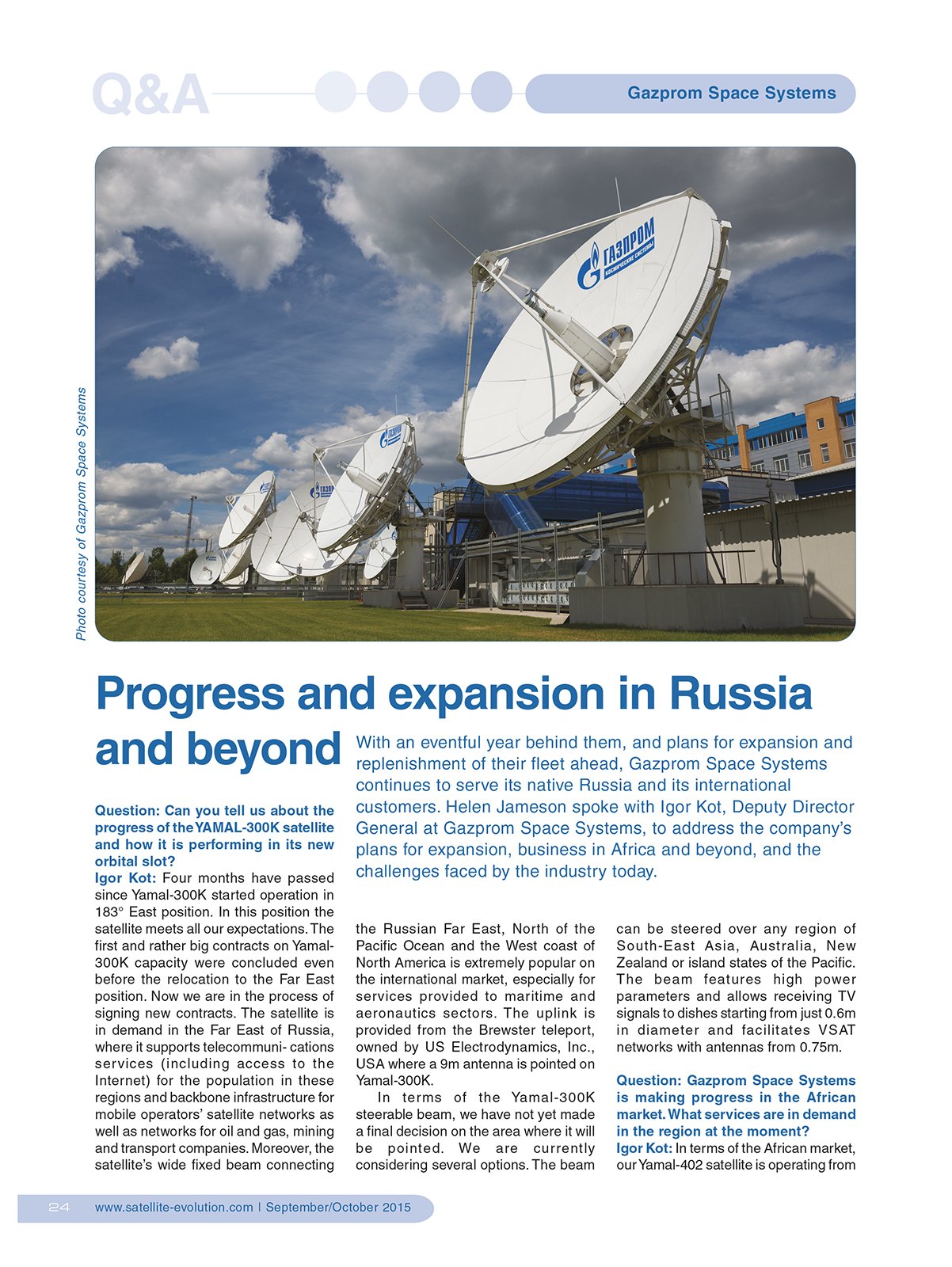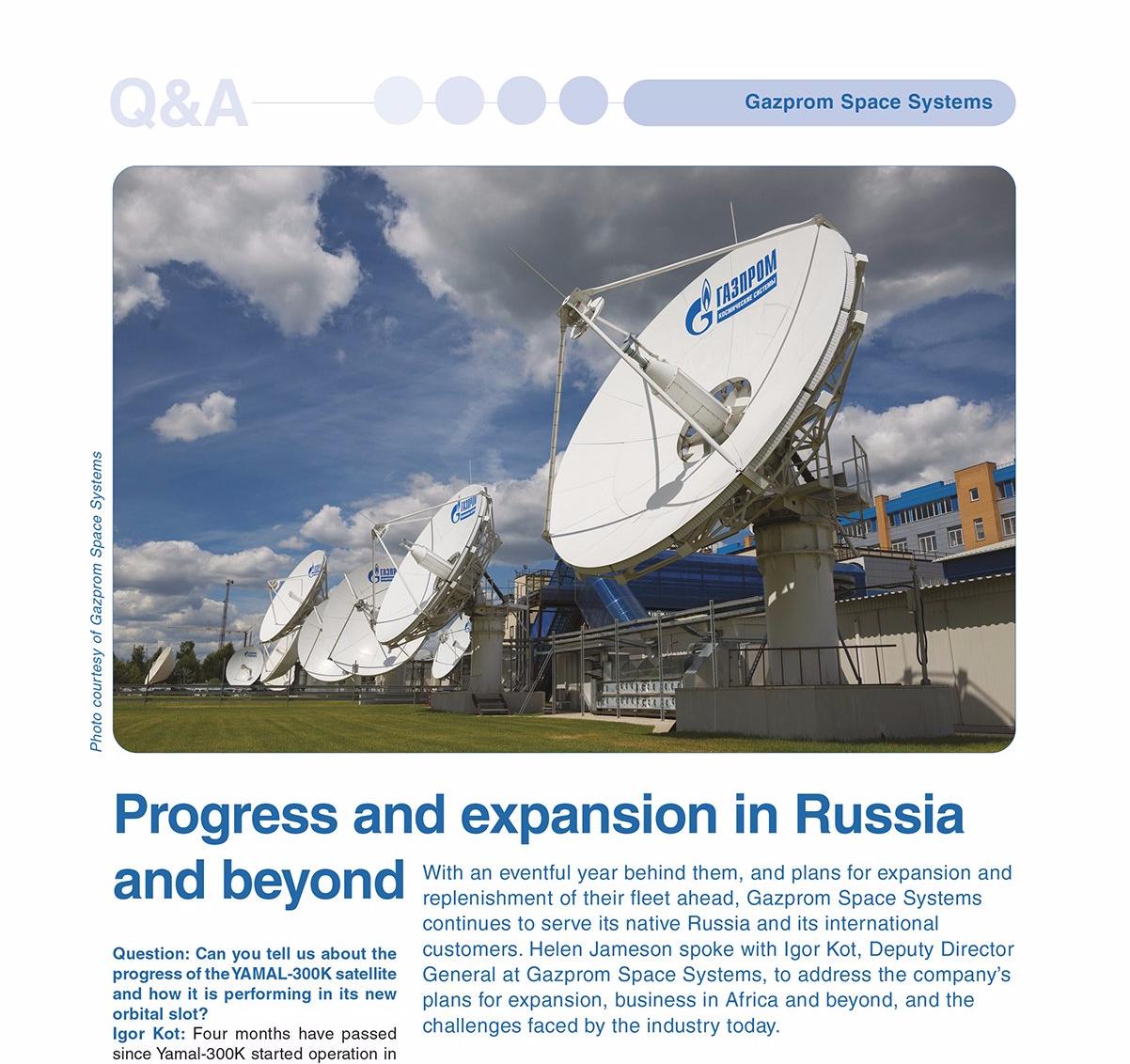News
 8 November 2015
8 November 2015
Progress and expansion in Russia and beyond
With an eventful year behind them, and plans for expansion and replenishment of their fleet ahead, Gazprom Space Systems continues to serve its native Russia and its international customers. Helen Jameson spoke with Igor Kot, Deputy Director General at Gazprom Space Systems, to address the companyâs plans for expansion, business in Africa and beyond, and the challenges faced by the industry today.
Question: Can you tell us about the progress of the YAMAL-300K satellite and how it is performing in its new orbital slot?
Igor Kot: Four months have passed since Yamal-300K started operation in 183° East position. In this position the satellite meets all our expectations. The first and rather big contracts on Yamal-
300K capacity were concluded evenbefore the relocation to the Far East position. Now we are in the process of signing new contracts. The satellite is in demand in the Far East of Russia, where it supports telecommuni- cations services (including access to the Internet) for the population in these regions and backbone infrastructure for mobile operatorsâ satellite networks as well as networks for oil and gas, mining and transport companies. Moreover, the satelliteâs wide fixed beam connecting the Russian Far East, North of the Pacific Ocean and the West coast of North America is extremely popular on the international market, especially for services provided to maritime and aeronautics sectors. The uplink is provided fr om the Brewster teleport, owned by US Electrodynamics, Inc., USA where a 9m antenna is pointed on Yamal-300K.
In terms of the Yamal-300K steerable beam, we have not yet made a final decision on the area where it will be pointed. We are currently considering several options. The beam can be steered over any region of South-East Asia, Australia, New Zealand or island states of the Pacific. The beam features high power parameters and allows receiving TV signals to dishes starting fr om just 0.6m in diameter and facilitates VSAT networks with antennas fr om 0.75m.
Question: Gazprom Space Systems is making progress in the African market. What services are in demand in the region at the moment?
Igor Kot: In terms of the African market, our Yamal-402 satellite is operating from 55oE orbital slot. Its southern beam is used for a variety of applications including: the government sector, oil and gas companies, mining, maritime, television (for instance governmental TV in Angola and South African sports channels), Internet access and VSAT networks (based on iDirect, Hughes and SkyEdge platforms).
Question: Which regions of Africa are you already doing business in and wh ere would you like to expand business to?
Igor Kot: Yamal-402 capacity is utilized almost on the whole Sub-Saharan Africa territory, mostly in southern, central and eastern parts wh ere technical parameters are better. We also have subscriber stations in Western Africa but there is still room to grow. Most of our end users are concentrated in The Democratic Republic of the Congo â a country with a population of 75 million people, difficult landscape with territories wh ere fibre optics have not yet been deployed. At present, the Yamal-402 Southern beam is used not only in loopback mode but also in cross-connection with the European beam.
Question: On which other regions are you currently focusing your attention?
Igor Kot: Gazprom Space Systems is a Russian Satellite Operator and 70 percent of Yamal satellite capacity is dedicated to serving our country. Apart from satellite capacity here we provide turnkey telecommuni- cations services. Our satellite communications network consists of around 1,000 ground stations and a half of them are operating in the interests of Gazprom Group â our main shareholder.
Nevertheless, we have devoted much attention to our sales on the International market. In addition to our own funds, we developed the GSS infrastructure and attracted multicurrency credits and we have to fulfill the repayment obligations in the correspondent currencies. It is important that now we are increasing sales on the international market and, respectively, revenue in foreign currency.
This enables us to reach a balance between foreign currency and ruble components in our obligations and revenues and to ensure the financial stability of the company.
Question: You are aiming to fill your satellites by the end of 2016. Is there still much work left to do in terms of heightening the fill rate on the satellites?
Igor Kot: Well, a significant portion of the planned work has already been done. Certainly not all projects supported by Yamal satellites are big. And some transponders we fill literally âbit-by-bitâ. But we are going the right way, we continue to actively work and, I think, by the end of 2016 we will have some good figures.
Question: What are your future plans for the expansion of the Gazprom Space Systemâs fleet?
Igor Kot: In contrast to the last three years, during which three new Yamal satellites were launched, the next few years are going to be rather calm. Our next satellite Yamal-601 is planned to be launched in 2018. It will be launched within the framework of a new big investment cycle that we are beginning this year to renew and expand our satellite constellation. In total, by the end of 2025, we are planning to launch at least five new satellites though the main investments will be accounted for in the next two to three years.
Question: What challenges does the satellite industry face at present?
Igor Kot: First of all - tough competition, especially in the African market, due to a significant increase in the supply of satellite capacity. Several dozens of geostationary satellites serve the region of sub-Saharan Africa, with most of them launched since the beginning of last year. At the end of 2015/beginning of 2016, new high-power satellites including HTS are planned for launched. The O3b satellites are gaining popularity.
Besides all this, the deployment of fibre-optic networks in remote regions also leads to increased competition and increased pressure on prices. All this applies not only to Africa, but also the Middle East, Southeast Asia and the Pacific.
Question: What progress would you like to see the company make by this time next year?
Igor Kot: Our main target for the next year is loading our existing satellites. Here it is important for us to fill not only fixed beams but also the steerable beams of Yamal-402 and Yamal-300K. Yamal-402 steerable beam can be pointed over Africa and, like the southern beam, can operate in loopback mode within Africa or connected with Europe with the help of the northern beam.
Recently we have received some requests about capacity in this beam and now we are estimating the optimal coverage zone. In the near future we hope to make a final decision on the area of the beam pointing and to start selling its capacity.
ID : 7903
Mnemonic code:
Name: Progress and expansion in Russia and beyond
Tags: publications
Preview image:

Information Block ID: 66
Information Block mnemonic code: news
Information Block name: News
ÐÐĩŅŅÐļКаÐŧŅÐ―Ð°Ņ КаŅŅÐļÐ―ÐšÐ° ÐīÐŧŅ Ð°Ð―ÐūÐ―Ņа: N
ÐзÐīаŅÐĩÐŧŅŅŅÐēÐū: Satellite Evolution
September/October 2015
ÐĪаÐđÐŧ Ņ ÐŋŅÐąÐŧÐļКаŅÐļÐĩÐđ: Download
